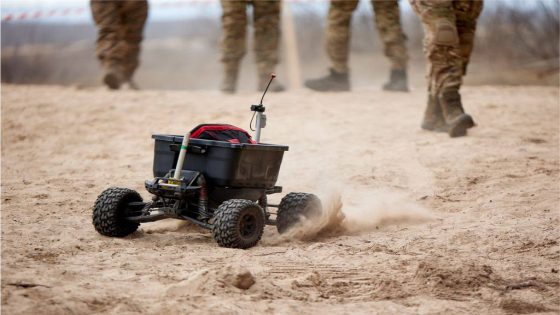The head of Ukraineâs strategic industries declared 2024 âthe year of land systemsâ as his country rushes more drones to the battlefield.
âYou will see more of them on the frontline,â said Oleksandr Kamyshin, speaking with reporters on the sidelines of the NATO summit in Washington. âThatâs one of the game changers we expect in the nearest 12 months.â
Uncrewed weapons have been key to Ukraineâs self defense to this point in the war. Naval drones have afflicted Russiaâs fleet in the Black Sea â which has needed to move farther east after having around 20 ships sunk or damaged. And aerial drones have become crucial for targeting and attacks on the front lines, where some 10,000 are lost every month.
Dressed in his usual black polo and fatigue-style pants, Kamyshin spoke at an event to promote Ukraineâs state-owned defense industry: Ukroboronprom. His comments followed a presentation on what Kyiv could produce on its own and where it needs help from foreign governments, defense companies and venture capitalists.
The increase in ground robotics Kamyshin predicted will come from manufacturers inside Ukraine, a sprawling network of volunteer, commercial and state-backed efforts. It also includes American companies partnering with Ukrainian firms to help improve their own kit.
Adam Bry, head of the drone maker Skydio, told Defense News in an interview last month that Ukrainian drone builders are the most advanced in the world. The land-based drones will perform a variety of missions, Kamyshin said, including demining, medical evacuation and combat itself.
Their main use, though, will be lightening some of the burden on Ukrainian soldiers fighting near the 600-mile front line. Ukraine lowered its eligible draft age from 27 to 25 earlier this year to help with some of its personnel shortages while fighting a much larger neighbor.
âThe main point [is that] we try to get our people back from the front line,â Kamyshin said.
In addition, he said Ukraineâs aerial drones were already using artificial intelligence to target Russian positions and that the use of such software would expand in the coming year.
The Pentagon itself is pushing to use more autonomous as it faces a size disadvantage of its own: against China in the Indo-Pacific. In the last several years, the U.S. government has reviewed its policies on artificial intelligence and warfare, one part of the Replicator initiative â an effort to rush more drones to military leaders in the Pacific.
âWe do our best to keep in mind all those ethical things, but at this point we have to work out a solution that will get more Russians out of my country,â Kamyshin said. âThatâs the ethical dilemma we have now.â
Drones are one of Ukraineâs many equipment needs.
The country is still trying to source more artillery shells after a yearslong ramp up in the west. To do so, Kamyshin said, it will need two things: explosive components like TNT and money. The U.S. State Department, along with other countries, announced $2 billion in Foreign Military Financing for Ukraineâs defense industry earlier this year.
The money will help mature Ukraineâs domestic production in the long-term, but Kamyshin said it wasnât enough.
âWe are looking for another $10 [billion] to $15 billion,â he said.
Noah Robertson is the Pentagon reporter at Defense News. He previously covered national security for the Christian Science Monitor. He holds a bachelorâs degree in English and government from the College of William & Mary in his hometown of Williamsburg, Virginia.
Source Agencies

